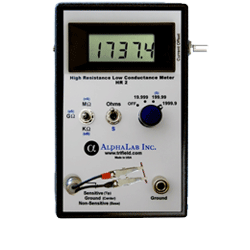Description
The Model HR2 meter measures resistance in nine ranges from 1 ohm to 1.9999 Tera ohms (1.9999×1012ohms), and conductance in a single range of 0.00 to 199.99 pS (pico siemens, or pico mhos), all at low voltage of < 2 volts across the sample. Basic accuracy is +/- 2% of reading +/- 1 count. For resistance higher than 1.9999 Tera ohms, the conductance range can be used to measure conductance down to 0.01 pS (100 T ohms). The meter has a conductance range because samples with simultaneously high resistance and high capacitance settle faster to their final value on conductance (usually under one second), than on resistance (several seconds), and conductance is also capable of detecting higher resistance than the resistance ranges can. Note that resistance in units of T ohms is the inverse of conductance in pS, so that the resistance can be calculated from the conductance. For example, 100 pS is 0.01 T ohm (10 G ohm), and the highest readable conductance of 199.99 pS is essentially 5 G ohms.
Resistance ranges are 19.999 K ohms (minimum digit represents single ohms), 199.99 K ohms, 1999.9 K, 19.999 M, 199.99 M, 1999.9 M, 19.999 G, 199.99 G, and 1999.9 G ohms. The single conductance range is 199.99 pS. There are two offset controls; one control sets the “zero” for resistance, which is determined while the terminals are shorted together. When set correctly, all nine ranges will read zero, and this control will generally never need to be altered. (It is set correctly as shipped.) The other offset control is a knob on the right side for offset current. It should be set for zero while on the conductance range with nothing connected to the terminals. The correct setting of this control is slightly temperature-sensitive, and should be re-zeroed if the temperature changes by more than 5ºC. With each of the nine resistance ranges, there is a constant current that flows through the unknown resistance. Current decreases by factors of ten, from 0.1 mA on the 19.999 K range, to 1 pA on the 1999.9 G range. On conductance (when both knobs set to the blue “pS” as in the photo), one volt is applied across the unknown resistance.
The restive sample (unknown resistance) is connected at two points; the “Non-Sensitive Terminal” is the source of current (or of 1 volt in the pS range), and the “Shielded Sensitive Terminal” is connected to a high-impedance amplifier, which uses feedback to hold the sensitive terminal at ground potential. In the photo, a piece of sandpaper (1867.3 G ohms) is connected to two short flexible clips, which is the most common method of connection. For measurements farther from the meter, 50 cm cables (with alligator clips at the ends) are also included. The “Sensitive Terminal” cable is a BNC coaxial type. The other terminal cable is a standard banana type. The “Case Ground” banana terminal on the left allows for the connection of a conductive enclosure to reduce outside interference, if needed. When measuring high resistance, the sensitive terminal should be shielded from any people or objects moving nearby because moving charges will cause interference. Any open-top metal box or a simple aluminum foil enclosure connected to case ground can do the shielding. A conductive box that plugs into case ground (shown) is an available option.
The meter is battery-powered with a standard 9 V replaceable battery (included), which operates about 40 hours before the low battery indicator comes (on indicating about one more hour of battery life).
Specifications
Measures resistance in 9 ranges from 19.999 K ohms to 1999.9 G ohms). Accuracy is +/-2% of the reading +/- 1 count. The 9 measurement currents are 100 micro amps down to 1 pico amp in factors of 10.
Measures conductance in one range: 199.99 pico siemens. Accuracy is +/-2% of reading +/- 1 count. During conductance measurements, 1 volt is applied across the component.
Battery is a standard rectangular 9 Volt type, with “LOW BATTERY” appearing on the display when approximately one hour of battery life remains. Battery life is about 50 hours using an alkaline, and 25 hours using a regular battery. A battery is included.


